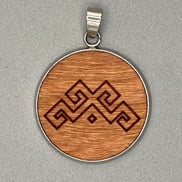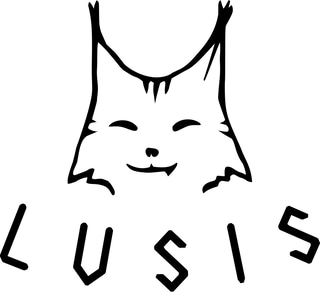Baltic


Auseklis
Auseklis is a significant symbol in Latvian culture, representing the morning star, typically identified with the planet Venus. It is deeply rooted in Latvian mythology and folk tradition, symbolizing light, hope, and protection against evil. Auseklis is also associated with the renewal of life and the victory of light over darkness, reflecting its appearance just before sunrise. Visually, the symbol resembles an eight-pointed star and is often used in Latvian folk art, textiles, and ornaments. In mythology, Auseklis is a celestial deity, often described as a youthful and energetic male figure who plays a role in the divine courtship stories involving the Sun's daughter. His presence in dainas (Latvian folk songs) highlights themes of purity, cosmic order, and romantic pursuit.


Austras koks
The Austras koks, or "Tree of Dawn," is a profound symbol in Latvian culture and mythology, representing the axis of the world and the connection between the heavens, earth, and underworld. Often depicted as a stylized tree, it embodies growth, life, continuity, and spiritual harmony. The Austras koks is central to the ancient Latvian worldview, symbolizing the cosmic order and the cyclical nature of life. In Latvian folklore, the Austras koks is linked to the rising sun (Austra), marking the beginning of a new day and symbolizing light, rebirth, and awakening. It stands in the mythical east, where the sun is born and where the gods reside. This tree serves as a metaphorical bridge between humans and the divine, reflecting the unity of all existence. The symbol frequently appears in Latvian folk art, especially in textiles, woodwork, and jewelry, often used as a protective emblem. During the Latvian National Awakening in the 19th century, the Austras koks also became a symbol of cultural identity and national pride. Today, it continues to be a cherished motif, representing deep-rooted traditions, the natural cycle of life, and the spiritual heritage of the Latvian people.


Jumis
In Latvian culture, Jumis is an ancient fertility deity symbolizing abundance, prosperity, and a good harvest. Closely tied to agriculture, Jumis is believed to reside in the fields, especially in places where two ears of grain grow together on a single stalk—a natural occurrence considered a sacred sign of his presence. Finding such a "Jumis" during harvest was seen as a powerful omen of wealth and productivity. During the harvest season, especially in the autumn festival Apjumības, Latvians performed rituals to "catch" Jumis. The last sheaf of grain was often braided into a figure or decorated and brought into the home or barn to ensure that Jumis would stay through the winter, bringing fertility and luck to the household and fields. Jumis is also symbolically represented as a dual or paired figure, reflecting the concept of unity, growth, and multiplication. This duality emphasizes balance and harmony in nature and life. Even today, the motif of Jumis appears in Latvian folk art and ornamentation as a sign of blessing and continuity.


Krupītis
In Latvian culture, Krupītis refers to the toad, a creature with symbolic and magical significance in folklore and traditional beliefs. Though modest in appearance, the toad was often seen as a guardian of hidden treasures, a bringer of rain, and a symbol of fertility and earth-bound wisdom. Krupītis was generally treated with respect and even reverence in folk beliefs. People believed that harming a toad could bring misfortune or bad luck, as it was thought to possess spiritual power or be protected by deities like Māra, the goddess of the earth and fertility. In some regions, toads were linked to the soul or spirits of ancestors, acting as silent watchers over the household or farm. In folk medicine and magic, the toad sometimes featured in protective charms or spells, believed to ward off evil or ensure prosperity. Its close connection to the earth and water made it a liminal creature—one that moves between different realms of nature. While modern views often overlook such symbolic associations, Krupītis in Latvian tradition embodies a blend of humility, mystery, and spir itual presence, reflecting the ancient animistic worldview where even the smallest creatures held deep cultural and sacred meaning.


Laima
In Latvian culture, Laima is one of the most important deities in traditional mythology, representing fate, destiny, and the cycle of life. She is often regarded as the goddess who determines a person’s life path, including their birth, fortune, and death. Unlike the fixed concept of fate in some other cultures, Laima’s presence in Latvian folklore suggests a more nurturing and guiding role, offering blessings and protection rather than strict predestination. Laima is deeply connected to women’s lives, especially in matters of childbirth, motherhood, and family well-being. She was believed to visit newborns and determine their future, and offerings were made to gain her favor. Laima was also associated with time and the flow of life, sometimes appearing as three aspects or sisters, similar to the Fates in other Indo-European traditions, symbolizing past, present, and future. Rituals honoring Laima were often performed at significant life events—births, weddings, and even before going to war or embarking on a journey. In this way, she represents the moral and spiritual compass of life. Even today, Laima remains a symbol of care, fate, and feminine strength in Latvian culture, appearing in folklore, literature, and national identity as a guardian of human destiny.


Māra's water
"Māras ūdens" (Māra's Water) is a traditional Latvian symbol deeply connected to the goddess Māra, one of the most important deities in Latvian mythology. Māra represents the feminine principle, the earth, fertility, and protection of life. As her element is water, "Māras ūdens" symbolizes the life-giving, purifying, and nurturing aspects of water. Visually, the symbol often appears as a series of wave-like lines or a mirrored zigzag, representing flowing water. It signifies not only physical water but also the spiritual and emotional depths that water embodies—intuition, healing, and the flow of life. This symbol was traditionally used in folk textiles, carvings, and personal adornments to offer protection and to promote harmony and emotional balance. "Māras ūdens" is also seen as a connector between worlds—the earthly and the spiritual—just as water connects land and sky. It reflects the sacred role of women as life-givers and caretakers, emphasizing the importance of balance, compassion, and continuity. In contemporary Latvian culture, the symbol continues to carry deep spiritual meaning, honoring nature and the ancestral understanding of water as a sacred and vital force.


Mārtiņa zīme
In Latvian culture, the symbol "Martiņa zīme" (also known as "Mārtiņš zīme") is associated with the god Mārtiņš, a deity of war, order, and the protector of warriors and travelers. This ancient symbol is often represented as a double cross or a variation of crossed lines, reflecting balance, strength, and masculine energy. It is linked to the seasonal festival of Mārtiņi, which marks the end of the harvest and the beginning of winter. The symbol carries connotations of protection and renewal. It was traditionally used in folk art, clothing, and household items to ward off evil and maintain harmony. It also embodies the dualities of life—light and dark, life and death, war and peace—indicating the transition between seasons and states of being. Martiņa zīme serves not only as a protective emblem but also as a reminder of the warrior’s discipline and the importance of structure in both personal and communal life. Today, it remains a meaningful cultural motif, representing endurance, courage, and spiritual resilience in Latvian heritage.


Zaltkis
In Latvian culture, Zalktis is a sacred serpent, often depicted as a grass snake, and holds deep symbolic significance. It is associated with wisdom, fertility, and protection. In pre-Christian Latvian mythology, Zalktis was considered a guardian spirit and a symbol of the earth’s vitality. It was believed that Zalktis lived near homes, especially under thresholds or in the barn, and bringing harm to it would bring misfortune. Zalktis was also connected to the ancient Latvian gods, especially Māra, the mother goddess, and was seen as her sacred animal. Because of this, people would sometimes leave offerings such as milk or bread to appease the Zalktis, believing it would bring blessings and prosperity to the household. Importantly, Zalktis embodies harmony with nature. Unlike the negative connotations snakes have in many Western traditions, in Latvian folklore, Zalktis is not feared but respected and even revered. This positive image reflects the deep-rooted animistic worldview of ancient Baltic tribes, where every natural creature held spiritual value. Today, Zalktis continues to appear in Latvian folklore, literature, and symbolism, representing a link to the country's pagan heritage and nature-centered spirituality.


